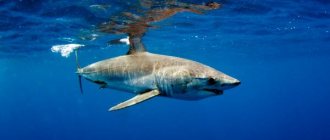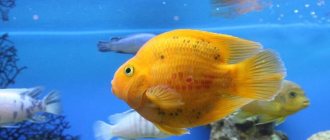Skeleton and musculature of sharks
Meat and cartilage of a predator
Sharks, like other vertebrates, need a skeleton to support, strengthen and protect parts of its body and internal organs. It serves as a support for soft tissues, a place for muscle attachment, a container and protection for internal organs. The skeleton of a shark consists entirely of many cartilages, almost all of them are connected into one whole with the help of joints, ligaments, tendons and other joints. However, it would not be entirely correct to assume that there are no highly calcified (i.e., bone) elements in the shark’s body. These include its teeth and plactoid scales, as well as the spiny spines of some shark species. However, these elements of the shark’s body do not belong to the skeleton, since by definition the skeleton is an organ that performs supporting functions for the body.
Shark skeleton
The shark skeleton is entirely formed from cartilaginous tissue and consists of the following main sections and sections:
Axial skeleton, the basis of which is the vertebral column, consisting of numerous cartilaginous vertebrae. The chord passes through the canals of the vertebra, penetrating the entire spinal column. The vertebrae are held together by remnants of the notochord, which is also preserved within the body of each vertebra;
Cranial section of the skeleton, consisting of two parts - the braincase and the maxillo-oral, including the gill apparatus. The shark skull consists of a solid massive cartilaginous cranium, in which the olfactory, visual, auditory and occipital sections are fused. The jaws bear teeth, pendulous and hyoid apparatuses, and cartilaginous gill arches. The skeleton of a shark's head contains from five to seven pairs of cartilaginous gill arches. The braincase of the skull of sharks is a solid cartilaginous container, the anterior end of which is extended into a rostrum that supports the snout. On the lateral surfaces there are eye sockets that protect the eyes; between the walls of the eye sockets there is a small shark brain;
Skeleton of the shoulder and pelvic girdles, unpaired and paired fins. The belt of the shark's anterior fins is formed in the form of a cartilaginous arch lying in the thickness of the muscular wall behind the gill region, and is in no way connected with the axial skeleton. On the lateral surface of this belt there is a special outgrowth, which is the attachment point of the fin skeleton. The pelvic fin belt of a shark looks like a cartilaginous plate that lies in the abdominal musculature in front of the cloaca. The skeleton of the ventral fin is attached to the lateral surface of the girdle, which consists of one elongated basal element with a row of radial cartilages attached to it. In males, the basal element serves as the skeletal basis of the pterygopodium, a copulatory outgrowth. The skeleton of unpaired fins consists of radials embedded in the muscles and penetrating the base of the fin.
The axial skeleton of the shark with its back part fits into the upper lobe of the shark's caudal fin, which is usually larger than the lower lobe. The fin blades are supported by elastostrichia , special elastinous tissues.
Despite the cartilaginous structure of the shark's skeleton, it has sufficient rigidity necessary to perform its functions. Areas that bear the greatest physical load (jaws, spine) are strengthened due to deposits of phosphorus and calcium carbonate in the form of interconnected granules. In many sharks, which are active predators, the upper jaw is not integral with the skull, but is attached to it with the help of movable ligaments, muscle fibers and cartilage. Sharks' prey can be large in size, and the ability to extend the upper jaw allows them to tear out larger pieces from the body of the victim or, for example, the carcass of a dead whale.
The cartilaginous skeleton is much lighter than the bony one, so sharks can maintain a certain buoyancy, even in the absence of a swim bladder. In addition, the flexibility of the cartilaginous skeleton is higher than that of a similar calcified one. All these skeletal qualities allow sharks to be fast and agile creatures.
Circulatory system of predators
In the internal structure of sharks, the circulatory system is represented by the heart, which has two chambers - the atrium and the ventricle, and blood vessels.
Through the gill artery, blood enters the gills, is enriched with oxygen and distributed throughout the body.
Sharks also have a spleen, a hematopoietic organ.
Sharks are poikilothermic, that is, cold-blooded animals. But thanks to the active work of the fish’s muscular system, their body temperature can be 10 degrees higher than the ambient temperature.
Read more about the ability of sharks to increase their body temperature in the article Warm-blooded sharks.
Watch the video - The structure of the circulatory system of a shark:
Myth 3. All sharks are big
Dwarf lantern shark.
Image: Chip Clark/Smithsonian Institution When most people think of sharks, they think of the great white shark, or Carcharadon, from Jaws. In fact, there are 400 different species of Shark Species / Shark Research Institute of these fish in the world, and they are very different from each other - in size, habits, and appearance.
So, the great white shark reaches How Big are Great White Sharks? / Smithsonian Ocean is 6 meters long and weighs about 1,900 kilograms. But there is an even larger shark, under 20 meters - a whale shark. She, as we mentioned, feeds on plankton.
However, in the ocean you can find not only such giants, but also truly tiny predators that fit in the palm of your hand.
For example, the dwarf shark reaches the LJV Compagno. Sharks of the World is only 26.5 centimeters long. In addition to it, there is a spiny shark - about 28 centimeters and an Indian ribbon shark - about 24 centimeters. These are peaceful and shy fish that do not pose the slightest danger.
And the dwarf lantern shark can even glow Dwarf Lantern Shark / Smithsonian Ocean using photophores - special organs on its belly. This helps her calmly swim and feed during the day: other fish, looking up, think that it was a glare of sunlight floating by.
Myth 4: Sharks roll over on their backs before biting.
The white shark attacks by turning over on its back.
Image: Brocken Inaglory / Wikimedia Commons In fiction, you can find claims that sharks turn on their side or back before they bite. So, in the novel “Twenty Thousand Leagues Under the Sea,” harpooner Ned Land used this feature to catch the moment to strike.
What's the use of my harpoon? You see, Mr. Professor, sharks are rather clumsy animals. To grab you, they need to roll over on their back...
Jules Verne
"Twenty thousand leagues under the sea."
But this is a myth that could cost a shark hunter his life. Diver and photographer Valerie Taylor of the Royal Australian Geographical Society has been photographing marine predators for almost 60 years. She has observed them hunting whales and other marine mammals and tells 10 myths about sharks / Australian Geographic that sharks do not have to roll over to bite.
In the recommendations of GA Llano. Airmen Against the Sea: An Analysis of Sea Survival Experiences / Arctic, Desert, Tropic Information Center, Research Studies Institute on sea survival for military pilots, experts from the US Aeronautical University also claim that a shark can bite from almost any position. They advise victims of a disaster and those who find themselves in the ocean not to rely on her imaginary clumsiness.
Myth 9. Sharks are loners
Caribbean reef sharks walk alongside the lemon shark.
Image: Albert kok / Wikimedia Commons This is not always the case: some of them are quite social animals. For example, lemon sharks constantly gather in schools because it is easier to get food and it is safer to be together.
They know how to somehow communicate and even teach DMP Jacoby. Social behavior in sharks and rays: analysis, patterns and implications for conservation / Wiley Online Library. Seriously, a fish that has figured out the easiest way to get food can show it to its fellow fish. Baby lemon sharks accompany the adults and learn from them how to hunt and avoid other predators.
Even the toughest and most intimidating sharks, the great white, are able to feed together without interfering with each other.
These predators can even play Is the White Shark Intelligent? / ReefQuest Center for Shark Research with each other and socialize, as well as establish complex hierarchical orders in their groups.
Digestive system of a shark
The shark's digestive system is similar to that of other fish. It begins in the oral cavity, equipped with a large number of teeth.
At the bottom of the oral cavity there is a small fold of mucous membrane - the tongue, which does not have muscles. Then the food enters the pharynx.
To prevent food from falling out of the gills, sharks have cartilaginous outgrowths on their gill arches - gill rakers.
The pharynx passes into the esophagus, through which food enters the stomach. The stomach of some sharks has the ability to “turn inside out,” freeing itself from undigested and inedible food debris.
The stomach is joined by the small intestine, which passes into the large intestine and then into the rectum. The large intestine has a spiral valve, which is an outgrowth of the mucosa that increases the absorption surface.
Read more in the article Anatomy of Digestion - How does a shark’s stomach work?
A protrusion extends from the large intestine - the rectal gland, which secretes an odorous secretion to attract individuals of the opposite sex.
Sharks also have a very large liver (which partially serves as the missing swim bladder), gall bladder and pancreas.
Remains of food enter the cloaca, where the ducts of the genitourinary system open.
Myth 5. Sharks don't get cancer
A tumor on the lower jaw of a great white shark, filmed near the Neptune Islands in South Australia.
Image: Andrew Fox / Sam Cahir / Fox Shark Research Foundation In collections of “incredible facts about nature”, a fairly common statement is that these marine predators never suffer from cancer.
But this, unfortunately for these fish and everyone who sympathizes with them, is not true. Scientists have documented Sharks Do Get Cancer: Tumor Found in Great White / Live Science the presence of cancerous tumors in at least 23 species of these predators, including the great white shark.
The myth that these cartilaginous fish are immune to cancer most likely stems from one 1983 study.
In it, scientists discovered A. Lee. Shark Cartilage Contains Inhibitors of Tumor Angiogenesis / Science in shark cartilage a substance that limits the development of blood vessels, and as a result, the growth of tumors. Journalists, as often happens, exaggerated a little and decided that since cartilage inhibits cancer, and sharks only have cartilage instead of normal bones, it means they don’t have tumors. But that's not true.
Myth 10. Sharks are the main danger in the sea
Hammerhead shark at the Georgia Aquarium.
Image: Josh Hallett / Georgia Aquarium / Wikimedia Commons Thanks to horror films, sharks are considered the most feared man-eaters of the sea. But statistics show that these fish do not live up to the expectations placed on them.
According to Shark myths and facts / The Australian Museum, cited by the Australian Museum of Natural History, sharks bite people on average 100 times a year. And about 10 cases are fatal. Mosquitoes, which carry various diseases, kill The deadliest animal in the world / Gates Notes more people per day than sharks have killed in the last 100 years in the world.
In fact, you have a better chance of being killed by lightning than this marine predator.
Sharks do not prey on humans or use them as a food source, so their attacks are very rare and random. For that matter, attacks by Shark myths and facts / The Australian Museum by stray dogs are twice as likely to be fatal. And meeting them is much easier.
But people kill about B. Worm. Global catches, exploitation rates, and rebuilding options for sharks / ScienceDirect 100 million sharks a year - for food and medicine (which doesn’t work anyway). So it’s not we who should be afraid of them, but they of us.
Origins of belief
If you do not take into account the tales of sailors told in port eateries since the days of sailing, there is no evidence of this fact. In modern mass consciousness, this myth was entrenched thanks to the novel, and then the film, “Jaws”[1].
Cover of Peter Benchley's novel Jaws
- Ogre. Other sharks also sometimes attack people, and for a variety of reasons - when they are hungry, scared, or when they smell blood in the water. By the way, this Watkins guy didn't get her period last night? - How should I know?! - Yes, I do, just out of curiosity. Hooper said that in this case, a shark attack is almost guaranteed if it is prowling somewhere nearby.[2]
The novel and the film were a huge success, and the “facts” voiced in them were firmly entrenched in people’s minds. Later they were consolidated by numerous other, albeit less successful, novels and films. The cover of this article uses a fragment of a poster from one of these films[3].
What fish lays spiral-shaped eggs?
Japanese bull sharks reproduce by laying eggs enclosed in a capsule entwined with a spiral comb. At one end there is a pair of short antennae.
Interesting materials:
Why are there several formulations of the second law of thermodynamics? Why are there irregular verbs? Why are beets sweet? Why is Svetlana Photinia? Why does the LED spotlight burn at full intensity? Why does fresh plaster crack? Why do Waxwings faint? Why do Waxwings faint in winter? Why do the pads on a bicycle whistle? Why is cheddar cheese yellow?
Muscles[edit]
Red and white muscles are the two muscles that sharks have for movement. Red muscles are used for "cruise control" or steady movement, while white muscles are used for fast and jerky movements. [12] Sharks such as the Great White rarely use their muscles, they use as little energy as possible and instead rely on their head and tail to guide their movements. Great white sharks use their heads to propel themselves, performing back and forth movements of the head to create areas of high and low pressure throughout the rest of their body. [13]
Camouflage [edit]
This gray reef shark exhibits reverse shading with a darker dorsal surface and a lighter ventral surface.
Sharks can have a combination of colors on the surface of their body, resulting in a camouflage technique called countershading. Darker color on the upperside and lighter color on the underside helps prevent visual detection by predators. (For example, the white color on the bottom of a shark blends with sunlight from the surface when viewed from below.) [17] [18] Anti-shading can also be achieved through bioluminescence in several species of sharks that produce and emit light, such as the kitefin shark. a type of sea shark. The species migrates vertically, and the arrangement of light organs called photophores provides ventral shading. [19] [20]
Some species have more complex physical camouflage that helps them blend into their environment. Wobbegongs and angel sharks use camouflage to aid in ambush predation. [21]
Myth 11. Sharks attack because they mistake people for seals.
Sharks don't consider these cuties to be people.
Image: “Mike” Michael L. Baird / Wikimedia Commons There is a myth that sharks kill swimmers for one simple reason: they confuse them with large pinnipeds. And when the predator realizes that it has made a mistake, it simply spits out the prey.
However, this is not true, although it sounds quite logical. Sharks often prey on seals and other marine mammals, but do not confuse people with them. They use different tactics: when attacking, they decisively tear and devour the animal immediately, and examine people carefully. Here's what Great White Shark Attacks: Defanging the Myths / National Geographic experts have to say about this.
I have observed over a thousand white shark attacks on sea lions. If they attacked people in the same way as pinnipeds, they would fly to the surface like torpedoes and simply tear the victim apart. But they approach them slowly and at ease.
R. Aidan Martin
Director of the ReefQuest Shark Research Center.
Sharks bite Great White Shark Attacks: Defanging the Myths / National Geographic people not because they look like seals. It's just their way of exploring the world. Instead of touching unfamiliar objects, as humans and monkeys do, these predators bite them. Although, if a great white shark bites a diver not out of anger, but out of curiosity, the victim will not feel any better.
There is even such an expression - “research bite”. Sharks constantly taste even inedible things to understand what they are, because they cannot feel them. There are no handles.
Shark anatomy: the internal structure of a predator
The topic of our article is sharks, the internal structure of which we will consider in the following order:
- Skeleton and muscles;
- Nervous system: brain and sense organs;
- Circulatory system;
- Breath;
- Digestion;
- Genitourinary system.
Has anyone tested the claim that sharks smell a drop of blood?
Of course I checked. I will give two examples of such research: scientific and popular science.
Florida Atlantic University Study
In July 2010, the Journal of Experimental Biology[4] published a study entitled “Olfactory Morphology and Physiology of Elasmobranchia”[5]. Elasmobranchians are a subclass of cartilaginous fish, which includes sharks.
The researchers tested several species of stingrays and sharks. The fish were placed in a tank with running sea water. Using a high-precision controlled dispenser, various amino acids were delivered directly to the sharks' noses. At the same time, the electrical activity of the cells in their nasal cavity was measured.
Slide with an experimental diagram from the mentioned work of scientists (Russification of the “Encyclopedia of Misconceptions”)
It turned out that the olfactory sensitivity of sharks is at the same level as that of more peaceful stingrays. They are able to distinguish the smell of an amino acid diluted in water in a ratio of 1 to a billion. This actually corresponds to the natural amino acid content of coastal waters. And to smell a few drops of blood at a distance of a kilometer requires sensitivity many orders of magnitude higher.
Photo of the experiment from the INSIDE SCIENCE portal with the caption “The myth of shark scent has been found untenable. Sharks are no better at detecting blood in the water than other fish.”
Blogger experiments
A similar experiment, only in natural conditions and in a more visual form, was conducted by the American blogger Mark Robert [6]. He received a mechanical engineering degree from Brigham Young University, a master's degree from the University of Southern California, and worked for NASA for 9 years. Mark runs a popular science channel on YouTube.
Mark Robert conducted two experiments in the open sea in shark habitats. In the first, he installed containers with human blood, urine, fish oil and sea water on four surfboards. Sea water was needed as a control liquid to maintain the purity of the experiment.
Video from Mark Robert's YouTube channel (https://www.youtube.com/watch?v=ugRc5jx80yg)
Liquids from all containers uniformly entered the sea in the same quantities. In an hour, human blood attracted 41 sharks, and fish oil attracted 4. Sea water and shark urine were not interested.
In the second experiment, Mark set up two boards with human blood and one with sea water. From the first container, blood was supplied drop by drop once a minute, and from the second - once every 4 seconds. The sharks were not interested in any of their boards.
Based on the results of the experiment, Mark Robert concluded:
“No one was interested in a device that released 15 drops of human blood per minute in the middle of shark-infested waters. You'll probably be fine if you get a small scratch."











